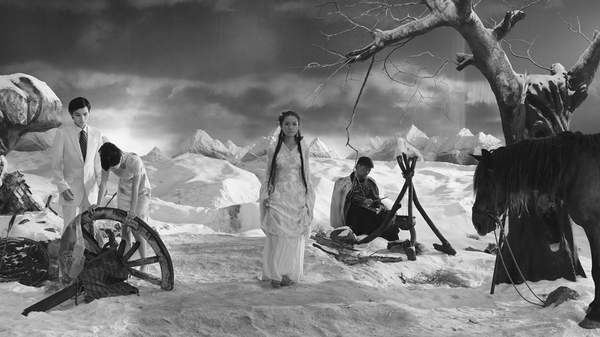Overview
After the assaultive colour and bombastic energy of DreamWorks: The Exhibition, the latest show in ACMI's main gallery is a very different animal indeed. The crown jewel of the centre's summer-long China Up Close program, Yang Fudong: Filmscapes showcases the work of the titular moving-image artist, exploring questions of modernity and alienation in contemporary Chinese society with varying degrees of success.
After descending the stairs into the darkness, visitors are greeted by the largest and best of the exhibition's four installations, titled The Fifth Night. Seven large screens along the main wall depict seven young people wandering aimlessly along a Shanghai street circa the early 1930s. The gorgeous black and white cinematography calls to mind countless classic film noirs, while the varying perspectives on the same scene offers the most compelling representation of the artist's favourite motif, that of characters traversing eerie artificial landscapes.
Attached to the main room is a single screen showing Yang's dialogue-free short film The Nightman Cometh (not to be confused with this). As snow falls on an empty battlefield, an ancient warrior clad in armour looks for shelter as three other figures make their way across the tundra. The most conventional piece in the exhibition in terms of form and presentation (keep in mind that 'conventional' is a pretty relative term), the 20-minute film is nonetheless beautiful to look at, although the invasion of ambient noise from The Fifth Night can be rather distracting.
In the next room, Yang forgoes his typical black and white for garish hi-def colour. With various screens of different shapes and sizes positioned all around the room, The Coloured Sky: New Women II depicts a group of young, attractive Chinese women lounging around an artificial beach. The emphasis on spectatorship, as well as the obviously fake set, provides comment on the manicured nature of femininity and female sexuality. Unfortunately, the disjointed manner of presentation prevents viewers from ever becoming fully immersed in the work, despite the hypnotic quality of the images themselves.
The final piece comes with the always intriguing disclaimer that some of the images within may cause viewer discomfort. East of Que Village is again shot in black and white, although it's far more raw and less vivid than the polished cinematography of Nightman or Fifth Night. Shot in a desolate village on the outskirts of Beijing, the multi-screen installation, laid out in a similar fashion to The Coloured Sky, juxtaposes images of feral dogs fighting each other with a group of humans likewise struggling to survive. By design, it's the ugliest work in the exhibition, as well as the most overtly political. Dogs eating dogs isn't exactly a subtle metaphor, after all.
